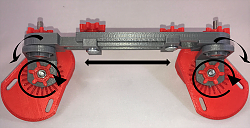Open-source, self-replicating rapid prototypers (RepRaps) have radically reduced the costs of three-dimensional (3D) printing while expanding its access. Three-dimensional printing's model of distributed manufacturing can produce medical technologies at significantly reduced costs. We investigate this potential by evaluating the viability of an open-source 3D printable infant clubfoot brace. Starting with a list of key features present in currently available clubfoot braces, a 3D-printed clubfoot brace was developed in free and open-source CAD software (FreeCAD) to enable future customization. Polylactic acid, a biodegradable and recyclable bioplastic, was selected among the various commercial 3D printable materials based on strength and cost. The results show that the open-source clubfoot brace matches or surpasses the physical features and mechanical degrees of freedom of all commercial- and nonprofit-developed brace designs while substantially reducing the costs of the braces to hospitals and families. The 3D-printed brace has the features of commercially available braces while significantly reducing the cost, making this clubfoot brace particularly appropriate for use in developing countries. In addition, the results indicated that this model of distributed manufacturing of medical technology is technically and economically appropriate through much of the Global South.
For more information, visit here:
https://www.appropedia.org/Open-Sour...Clubfoot_Brace
To download the paper, go here:
https://www.academia.edu/38580779/Op...Clubfoot_Brace



 LinkBack URL
LinkBack URL About LinkBacks
About LinkBacks



 Reply With Quote
Reply With Quote


Bookmarks